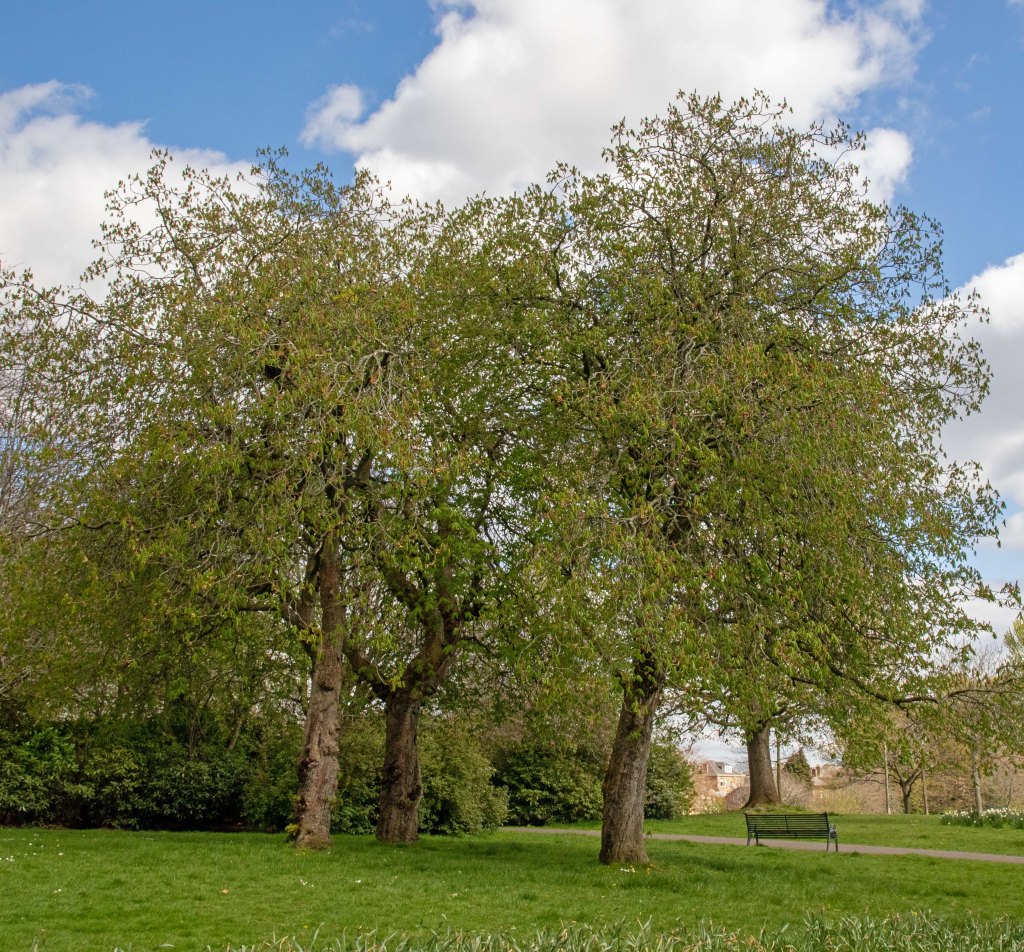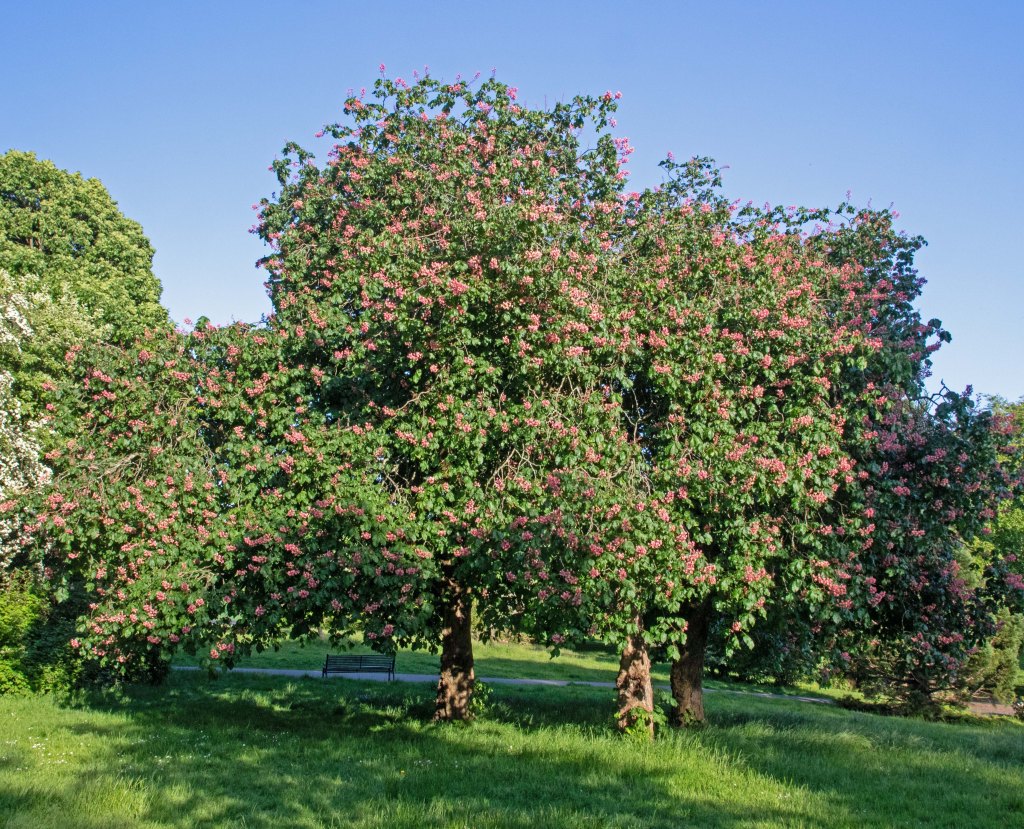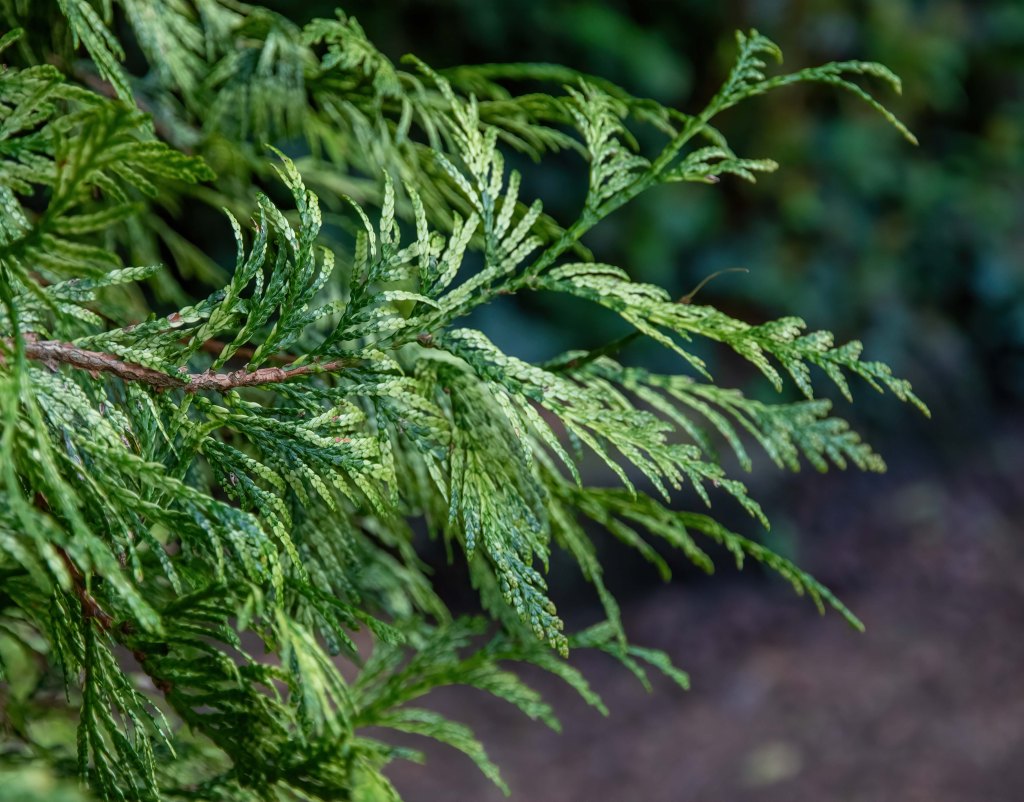
On a fine evening in May, 2019, Glasgow Tree Lovers’ Society visited Newlands Park for a ‘tree walk’. The Society’s Bob Gray kindly wrote this record of the walk for us to share here (with additions for a general readership by Julia Radcliffe and Alex Smith).
Despite its relatively small size—approximately 19 acres or 7.5 hectares—Newlands Park contains many interesting trees. The land was gifted to Glasgow in 1915 by Sir John Stirling Maxwell of Pollok and the park was created and laid out between 1915 and 1918.
This guide begins at the main entrance on Kilmarnock Road and progresses in a clockwise direction around the park.
The main entrance/NORTH WEST BOUNDARY
At this west end of the park grow several species of lime trees (Tilia) that include the broad-leaved lime (Tilia platyphyllos) and Crimean lime (Tilia xeuchlora).
Caterpillars of various moths—lime hawk, peppered, vapourer, triangle and scarce hook-tip moths—feed on lime leaves. Aphids and their predators, including hoverflies, ladybirds and many species of bird, are attracted to limes. Insects benefit from the nectar and pollen, particularly bees which also drink the aphid honeydew deposited on the leaves. Older trees provide dead wood for wood-boring beetles, and nesting holes for birds. Historically, lime trees were planted along roads by royal decree: it was thought they brought good luck for plentiful harvests. The Crimean, with its distinctive, shiny green leaves with big brown tufts under the vein joints, is considered to be hybrid between the small-leaved lime (Tilia cordata) and the Caucasian lime (Tilia dasystyla). Its glossy foliage makes it relatively aphid-proof, free from the production of honeydew and therefore more useful than other limes for situating in city streets.



the northwest boundary with St. Bride’s Road
Along the northwest boundary with St. Bride’s Road grow a number of rowans (Sorbus intermedia) with, at each end, some hybrid rowans (Sorbus x thuringiaca). This is a cross between rowan and common Whitebeam (Sorbus aria). A Sargent’s rowan (Sorbus sargentiana) with long stipules, long pointed leaflets and sticky buds can also be found. Rowans occur frequently in folklore and mythology. They have often been planted near houses or used to form gateways to garden paths – as a protection against evil spirits. The colour red was believed to be the most effective colour at warding off evil, therefore the rowan’s red berries were employed in this way. To fell a rowan was considered very bad luck in Scotland. Rowan wood was considered to have other mysterious properties: it has been used as divining rods and charms against rheumatism. Spoons made of rowan were believed to prevent milk from curdling.




South of the Carlaverock Road entrance
South of the Carlaverock Road entrance grows a group of three horse chestnuts (Aesculus x carnea), a cross that occurred in 1818 in Europe between horse chestnut (Aesculus hippocastanum) and the south-eastern USA buckeye (Aesculus pavia). The former has white flowers, the latter red and the hybrid flowers are dull crimson. The chromosomes of the cross have doubles and so the plant breeds true. Its bark is, however, very cankered. Aesculus in Latin means oak with edible acorns (although no part of this tree should be ingested—it has medium severity poison characteristics), and carnea means flesh-coloured or deep pink.




Just south of here grows an attractive Dawn Redwood (Metasequoia glyptostroboides), famously discovered in 1941 in eastern Szechuan. Seeds subsequently arrived at the Arnold Arboretum at Harvard University and, from there in 1948, they were dispatched around the world. Another Dawn Redwood, possibly self-seeded from the first, can be found further along the main path, on the other side, towards the pond.
One of the most important and distinctive trees in the park is the smooth Arizona cypress (Cupressus arizonica var. glabra), introduced to the UK in 1907. Although it originates where the summers are long, hot and dry it is very hardy and soil tolerant. It has bluish, wiry foliage, and long-lasting cones.


south-east of the Carlaverock Road entrance
Just south-east of the Carlaverock Road entrance grow three established red oaks (Quercus rubra), planted by the Glasgow Tree Lovers’ Society in 2006 in memory of Cardinal John Winning who lived in this part of the city. These oaks are native to the eastern side of North America from Nova Scotia to Texas and are part of the American ‘black oak’ group, which possess characteristics different from the ‘white oaks’ of Europe (including the British Isles). The latter is exemplified by a fine specimen of a Caucasian oak (Quercus macranthera) growing nearby. The rare Caucasian oak with its whiskered buds is not to be confused with the more commonly planted Hungarian oak which has no whiskers (see Tollcross and Pollok parks for the latter).


To the east of the Caucasian oaks, there is a small English Oak (Quercus robur). It sits alone in the centre of the grass, looking like a story-book illustration of an oak tree. According to Forestry and Land Scotland, oak trees once accounted for third of all tree cover in Britain. The lifespan of an oak is 800 years. Across Europe and Asia, oaks are known to support 500 insect species. Oak leaves were once used to make wine, and the trunk once made an edible source of gum.
Carlaverock Road boundary
Along the northern, Carlaverock Road boundary, there is some Highclere holly (Ilex x altaclarensis), a cross between a female Madeira holly and male common holly. It is possible to compare differences with the adjacent common holly (Ilex aquifolium). Highclere has glossy leaves, few (if any) spines, orange-red berries on female plants – and is resistant to pollution. Common holly is also known as English holly, European holly, or Christmas holly. It has strongly spiny leaves and bright red berries. It is native to western and southern Europe, northwest Africa and southwest Asia.


Towards the northeast corner is a group of tall, close-grown grey poplars (Populus canescens), a hybrid between Populus alba and Populus tremula. It is intermediate between its parents, with a thin, grey downy coating on its leaves. The male catkins are grey to red, the female inflorescences (catkins) are greenish. These trees are males – more commonly planted than their female equivalents in order to avoid the spread of woolly fruits. They can grow up to 30m. ‘Populus’ refers to the fact that these trees were often planted around public meeting places in the Roman Empire. Poplar wood is relatively soft and is used to make paper, cardboard and veneer.
At each side of the café grow two acers, and across from the café, at the main path, two fastigiated hornbeams (Carpinus betulus ‘Fastigiata’)—fairly commonly grown in Glasgow’s parks and streets.
The Rockery
In the rockery (to the east of the pond) grow a number of healthy Meyer’s juniper (Juniperus squamata ‘Meyeri’). These small glaucous trees, with flaky bark, silver, needle-like foliage, upward, spreading branches and arching, nodding shoot tips, are commonly grown but, increasingly, subject to dieback caused by the fungus-like pathogen Phytophthora austocedrae.
The rockery contains a Pinus Nigra—the Austrian pine or black pine. Introduced to the UK in the eighteenth century, it has an irregular, dense crown and beautiful, pale brown cones. It grows at 60cm a year but can be pruned and shaped. “The needles are stiff and arranged in pairs, longer, greener and more dense than Scots Pine needles. The new growth in the Spring takes the form of bright green ‘candles’. The bark is grey and fissured with silvery plates that turn orange-red and flake.


The rockery also contains a few variegated Western red cedars (Thuja plicata ‘Zebrina’) with their pineapple-scented foliage.


southeastern corner
Farther from the eastern boundary and into the southeastern corner grow smooth Japanese maple (Acer palmatum), native field maple (Acer campestre) and Norway maple (Acer platanoides) which can be compared with each other.
An uncommon and solitary Alianthus Altissima, known as the Tree of Heaven and native to northeast and central China and Taiwan, grows in the south east corner.
In the corner that forms the junction of Beverley and Calderwood Roads are two fine, mature pedunculate oaks (Quercus robur).
NW to SE path
On either side of the main NW to SE path grow the park’s most talked-about trees: seven grafted golden sycamores (Acer pseudoplatanus ‘Brilliantissimum’), quite a stunning sight in the spring. They are small, with a dense, round head. Their common name, the shrimp-leaved maple, after the early, dazzling pink, unfurling foliage, is beautifully, visually descriptive. As they develop, the leaves turn first pale, yellowish-green, then darker green.



“For such a small park Newlands contains a fine, eclectic collection of interesting trees.”
Bob Gray, Glasgow Treelovers Society
all photos ©Fiona Godsman
